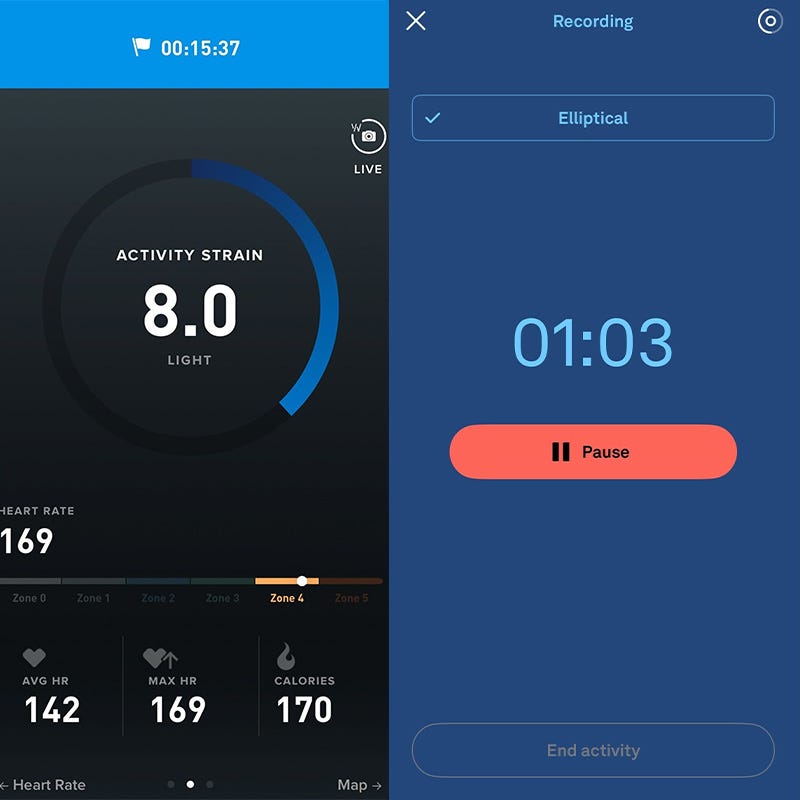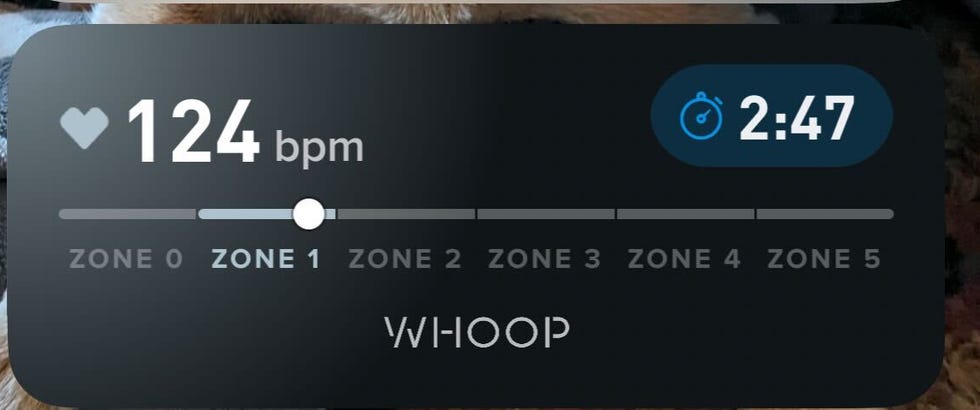Oura Ring vs. Whoop: Which is the Better No-Screen Fitness Tracker?

The smartwatch has become the default for fitness tracking for many runners and athletes. The screens on our wrists allow us to leave our phones behind and focus in, while still having up-to-date workout tracking at our fingertips. As the tech gets better, though, it's also gotten smaller, and more compact screen-less options are all the rage now. There is the smart ring, led by Oura, but lately Whoop has been leading the charge with a new screen-free form factor, the fitness band.
With so many similarities between the two leading devices, I figured most interested parties would need to choose one or the other. So, for the past month, I've been trying out both simultaneously to find which one is the more accurate fitness tracker—and more importantly which one I preferred using at the end of a month of workouts.
After four weeks of two to three days a week of mixed cardio and strength training, I've discovered that the tech behind both is great, but when it comes to exercise and fitness, I prefer the Whoop experience. Here's why.
Working out with Oura Ring 4I love wearing my Oura Ring. It fits great, only needs to be charged once a week or so, and is the most innocuous wearable I own. Even when I'm sweating on the elliptical, it doesn't slip off. It's perfectly comfortable for working out in. The rest of the experience is not as perfect.
To start, if you want any info while you're exercising you need to get out your phone. The Oura app is primarily focused on sleep, lacking more advanced workout tracking, but it does have basic functionality for recording heart rate during activity.
If you're taking a more passive approach to recording, Oura does have automatic detection and any activity you do will get recorded, with all the same info as if you'd done it manually. If all else fails, you can add workouts manually, which I found myself having to do on occasion of a shorter weightlifting session. Since this didn't lead to enough sustained heart rate activity, no workout was detected. In general, I found the detection much better for running and cardio workouts.
- Secure fit
- Comfortable to sleep in
- Trustworthy reliable data and up-to-date vitals
- Great battery life
- App is not great for active workout tracking
- Better for cardio tracking than for other forms of exercise
If you're used to a watch, the Whoop band can have a bit of an adjustment period. I can't tell you how many times I have checked for the time, only to remember there's not even a small clock screen. But once I honed in on the band as a pure training assistant, I started to really fall in love with it.
Like with my Oura Ring, in lieu of a watch face, I found myself working out with my phone out. But compared to Oura, the Whoop app is way more tailored to fitness tracking. It's not just sleep, but your daily stress and strain are always there up top, easily readable each time you open the app. When it comes to recording workouts, the Whoop app boasts an impressively long an in-depth list of activities, ranging from badminton to bartending. Once you start, you get all your vital metrics in real time, including your overall workout stress level which measures the ongoing intensity of your activity.

As you can see, the Whoop screen on the left gives you a lot more information. It's vital stuff too, like heart rate and calories burned. If you let it, you can even see your heart rate, heart rate zone, and activity duration on your lock screen for quick mid-workout checks.
I also found, especially when I was sleeping in it, the battery life to last about a week, a bit less than promised. If you're only using it for workouts the Whoop MG may last the advertised 14 days.

It's worth noting that my main goal for workouts is weight loss, and I as an ex-runner I tend to do a lot of cardio. This is a great fit for fitness trackers, like Whoop and Oura, that mainly rely on heart rate monitoring. Which is mostly to say if you're going to the gym to lift, there's not much you'll get out of it, but it'll be perfect for tracking cardio.
Whoop also comes with a more confusing subscription model. When you purchase your band you choose the named subscription with it. If you want the Whoop 5.0 band, you can chose the starter One for $200 a year or Peak for $239. The latter includes more features and a nifty wireless charging pack. The Life subscription comes with all these features unlocked and a Whoop MG (which stands for medical grade and includes an ECG and blood pressure insights) for a total of $359 a year. Since it's all wrapped up in one, the initial cost will be less than an Oura Ring... until that one year mark comes around and you realize you don't really own your device.
- Perfect fit for cardio focused training
- An impressive number of workout options in the app
- In app workout tracking better than Oura
- Overall, a more informative and elegant user experience
- Requires more charging
- Can be uncomfortable to wear casually
- Lifting doesn't count as much towards stress meter as it should
This is a comparison focused on exercise and fitness features, but considering that A) sleep is a key part of your holistic health and B) these devices encourage you where them to sleep, I felt it important to briefly touch on.
At the start of the testing period, I set myself the goal of sleeping in both of the devices every night. It took less than a week for me to realize I was not a fan of sleeping with my Whoop band on, similar to how I hate sleeping with smartwatches. It's uncomfortable and feels weirdly restraining.
In terms of sleep tracking data and sleep/readiness scores, my readouts from the devices were extremely consistent with one another. Oura and Whoop use the same metrics to determine these scores. This means it really just came down to comfort—and if that's the deciding factor then Oura is the one I much prefer for sleep tracking.
Oura Ring 4 vs Whoop MG, Who Wins?In general, I found there to be pros and cons to each of the screen-less wearables. With both the Oura Ring and Whoop, I felt pretty reliant on my phone if I wanted minute-to-minute vitals. Since a majority of this data is taken from heart rate, they also both prioritize cardio. For me, that lines up with my priorities, but for the plenty of people laser focused on their gains, there are mixed results here. Still, after a month of training with both I found it easy to make a decision.
Winner: Whoop
The Whoop band and its app feel more purposefully designed for fitness. While I definitely prefer the Oura Ring as a sleep tracker, the Whoop app and user experience is deeper and more versatile, casting a wide net for all types of athletes and performers.
- Perfect fit for cardio focused training
- An impressive number of workout options in the app
- In app workout tracking better than Oura
- Overall, a more informative and elegant user experience
- Requires more charging
- Can be uncomfortable to wear casually
- Lifting doesn't count as much towards stress meter as it should
esquire







